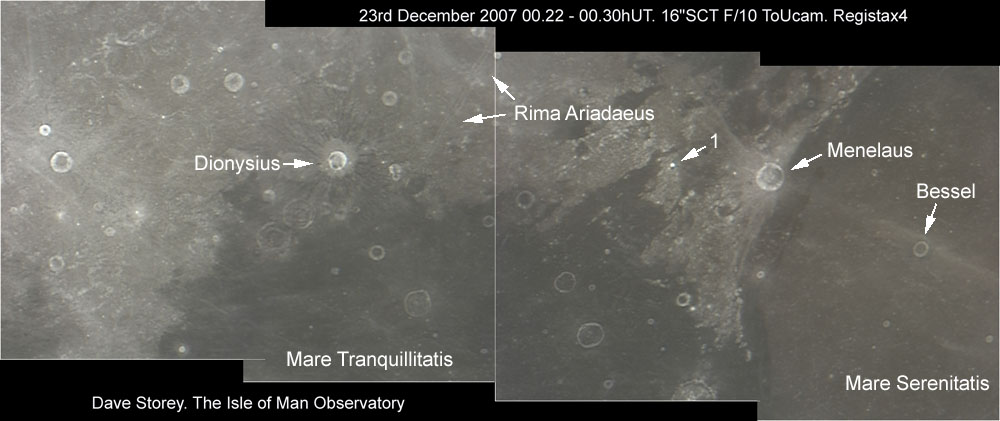LPOD Mar 12, 2008
Crater Rings, Spots and Rays during Full Moon

image by Dave Storey (click on it for the full-sized version, without labels) North is to the right
I quite often tell novice astronomers that the best time to observe details upon the lunar surface is during crescent to half phase of the lunar cycle, when shadow relief is brought out along the terminator. This is good advice but there are lots of delicate details to be gleaned when the phase is near Full Moon. First, this image is in colour and there is definite subtle colour to the surface. Then there are the numerous brilliant white rims of the lunar craters. Of particular interest is the splash of dark rays emanating from the 17.6-km diameter Dionysius, a crater with a particularly bright rim. Most lunar rille systems are best seen during low sun illumination, but under high sun many can be picked out as bright linear features. Rima Ariadaeus, for example, looks like a triple white line in places. Also, all over the image are splashes of white rays. Some of those from Menelaus may originate locally, but many of the others (like perhaps the bright ray near Bessel) are fall out from crater impacts well beyond the boundaries of the image. Finally, pick out the many hundreds (I haven’t counted them) of tiny white spots that pepper the lunar surface. Such white spots are also usually the signature of recent impacts, like "1" at the tip of Sinus Honoris. On closer inspection this unnamed feature can be seen to consist of a 1 km crater surrounded by 3-4 km of bright ejecta. Many more subtle white spots can be seen on the flat floors of Mare Tranquillitatis and Mare Serenitatis.
Dave Storey
Technical Details
16" Meade SCT at F/10. Imaged by Phillips ToUcam 740K. Processed Registax 4.
Related Links
Rükl plates 44,45,34,35,23 & 24.
Dave's website: IomStargazer Dave's Local Astronomical Society IoMAS
LPOD: Anti-Sun Moon
Editor's note: Chuck Wood is at the Lunar & Planetary Science Conference. LPODs for March 10 through March 16 are being posted by a Wikispaces members. You can contribute your own LPOD. It's easy! See the LPOD Index page for submission guidelines.
COMMENTS
To post comments regarding this LPOD, please click here and enter your text in the space below. You will not see the Edit tab unless you register for the wiki. Please do not edit the LPOD itself!
1) Thanks, Dave! Today I talked with the person who plans where the Kaguya HDTV obtains data. They will be entering a period soon where the flight path it is away from the terminator. I encouraged him to continue imaging because there are many fascinating things to see at higher Sun, just as you show today.
Chuck